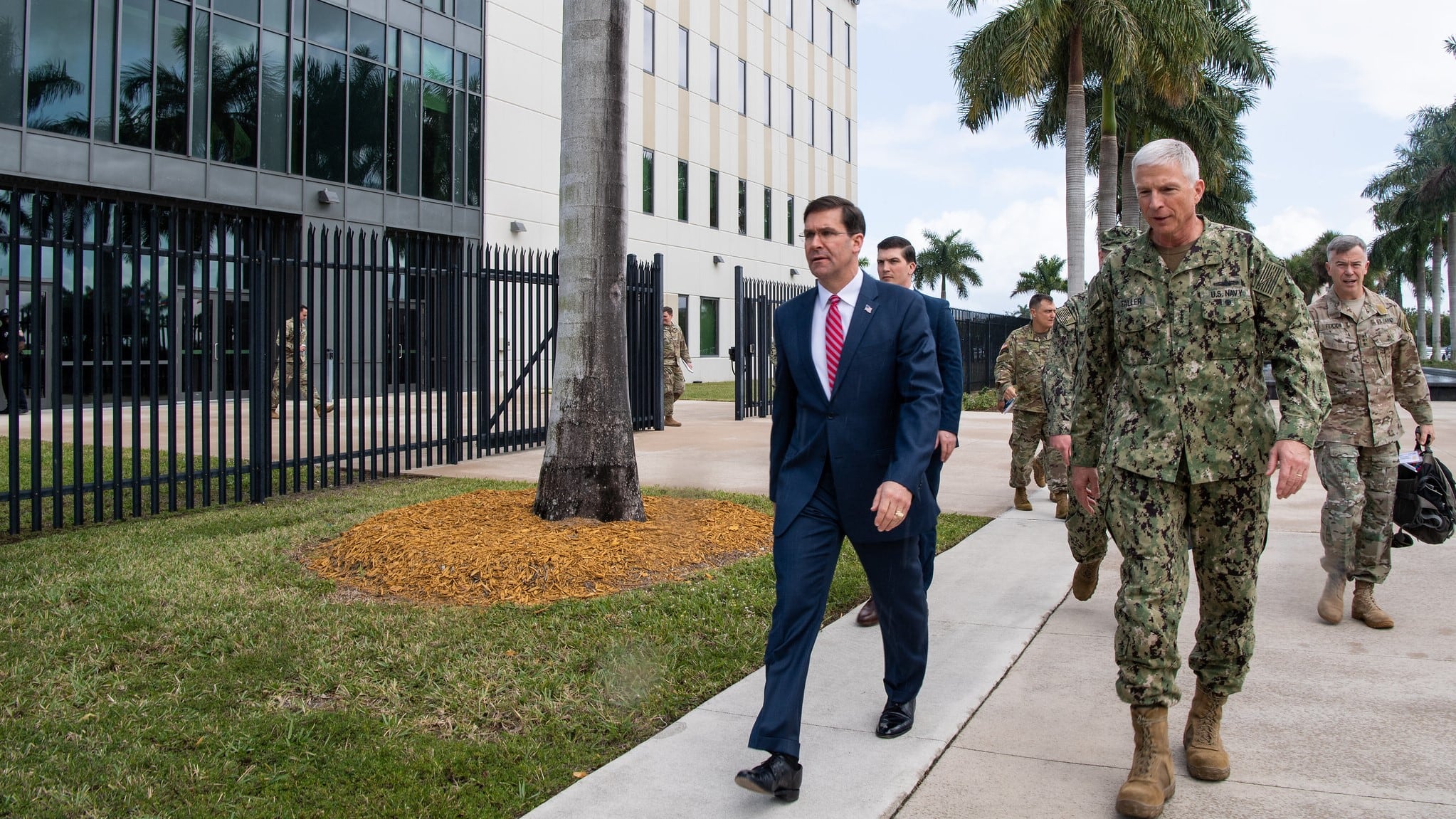US SOUTHERN COMMAND HEADQUARTERS, Miami — Secretary of Defense Mark Esper has begun a review of U.S. Southern Command, which could lead to cuts to the regional combatant command — or perhaps increased resources at a time that China and Russia are ramping up activity in the region.
Esper has said he plans to do a COCOM-by-COCOM review of U.S. force posture in order to asses how resources are being used and whether they should be redirected in some way. Those decisions will largely be driven by the needs of the National Defense Strategy. He hopes to have the reviews done by Oct. 1, the start of the next fiscal year.
Already a discussion about redirecting troops from U.S. Africa Command elsewhere was met with resistance in Congress, with leaders from both the House and Senate armed services committees warning the secretary against such a reduction.
On Thursday, Esper stressed that the review is only just starting, and that he is open to arguments that SOUTHCOM may need more manpower, not less.
“Everybody always assumes that when we talk ‘reviews,’ it means reductions. Not necessarily. That’s one of the notions I’ve been trying to dispel,” he told reporters while visiting SOUTHCOM headquarters in Miami.
“What I’ve talked about is making sure we have the proper footprint to implement the National Defense Strategy, whether in this command or any other command. So while it may mean right sizing, it may mean additional forces into the region. We talked about that, and capabilities and any other type of resources needed. That’s how I’m looking at this. It doesn’t mean reduction everywhere.”
Much of the focus on the reviews is about countering Russia and China, the latter of which has emerged as the main focus for the Pentagon over the last year. While that often is viewed through a U.S. Pacific Command lens, proponents of both AFRICOM and SOUTHCOM have argued that those are region where China has become significantly more active in recent years.
If SOUTHCOM were to gain assets, there are a few options that seem likely, according to a group of SOUTHCOM officials speaking on background.
Currently only 18 percent of aviation requirements and 21 percent of surface requirements identified by SOUTHCOM are being met. And while every COCOM says it is falling short of required needs, adding to the command’s number of “force packages,” consisting of a maritime patrol aircraft, patrol boat and helicopter would have tangible benefits. Specifically, such an increase could result in collection of approximately 35 metric tons more of cocaine each year per package put into operation.

Countering China in the region
Adm. Craig Faller, the head of SOUTHCOM, acknowledged his office is “short on intelligence and naval platforms for the counter narcotics” mission, but also said that increasing partnerships with nations like Colombia can help fill shortfalls. “
“We think as important as any more assets is getting the partners more in the game, and we have a plan to do that,” Faller said, to which Esper added: “This is one theater here where we really require a whole of government approach.”
That last point may show a way forward that helps SOUTHCOM without major movements of manpower or equipment. Asked what the biggest holes to fill for the command are, an official pointed to International Military Education and Training funds, or IMET. Those funds, used to train and educate military leaders from partner nations, was cut in recent years, ending up around $9 million in FY19.
The importance of that relatively small funding is in the ties with regional leaders, officials say, with roughly two-thirds of the chiefs of defense in SOUTHCOM’s area having attended American military educational facilities. Five ministers of defense in the region have also gone through American IMET programs — including, ironically, the minister from Venezuela, a country taking up a lot of SOUTHCOM’s energy in recent years.
Both Russia and China have invested in IMET in the region, although China’s efforts trend more towards junkets for individual officers. Russia’s program has expanded in the past few years, with roughly 1,000 graduates from its Nicaraguan-based counter-terrorism training center, representing every country in South America, per the officials.
IMET aside, one of the officials told reporters that China’s activity in South America has been “nothing short of a transformative shift” since president Xi Jinping came to power in 2012.
Chinese investment in the region, including private sector and state directed investment, was in the $10-$20 billion range at the start of the millennium. That is now up to $180 billion, according to SOUTHCOM numbers, and Xi has stated a goal to get to $500 billion by 2025. That has coincided with China becoming the number one or number two trading partner with much of the region, with influence becoming apparent with
“What’s concerning is the pattern of activities we’ve seen in AFRICOM, we’ve seen in [U.S. Central Command], we’ve seen in PACOM, whereby reasonable investments, reasonable exchanges with perfectly legitimate loans, for example, have eroded the sovereignty of our partners and present potential security concerns” for America, the official said. As an example, he pointed out that three nations that recognized Taiwan in the region have, in the last year, stopped doing so.
Another area of need, a second official said, was intelligence. Fifteen years ago, there was a division of intelligence staff working on Colombian issues, he said; now, SOUTHCOM has just two. Adding true China experts who understand Chinese thinking and Beijing’s system would also help, he added.
Aaron Mehta was deputy editor and senior Pentagon correspondent for Defense News, covering policy, strategy and acquisition at the highest levels of the Defense Department and its international partners.




